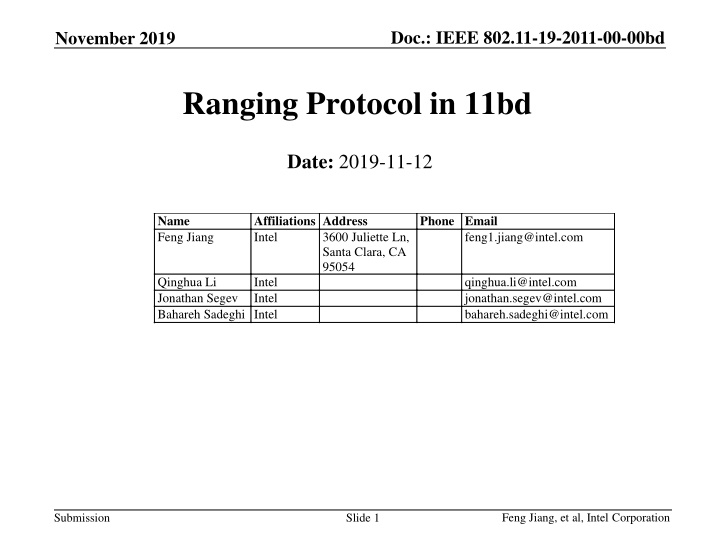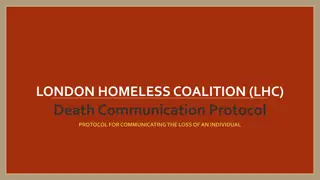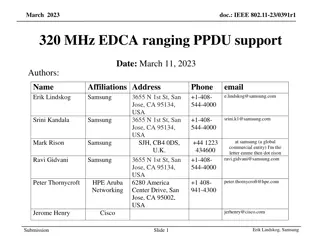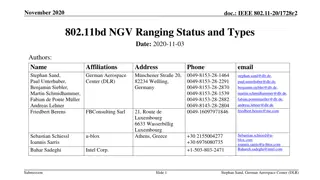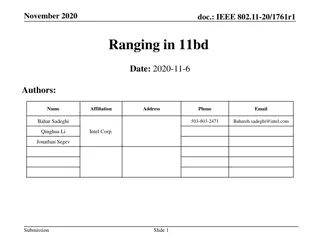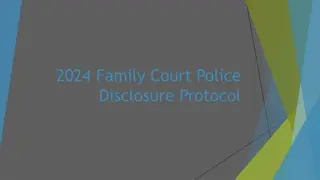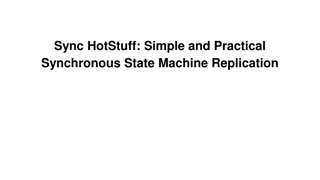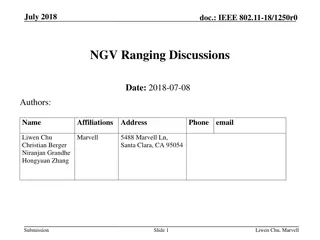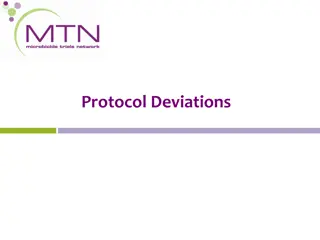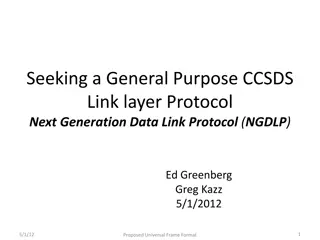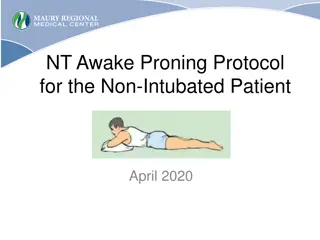Ranging Protocol Overview
In November 2019, a ranging protocol for IEEE 802.11-19-2011-00-00bd was proposed by Feng Jiang et al. This protocol supports sub-meter accuracy and utilizes round-trip-time (RTT) ranging for different bandwidth PPDUs. The submission details the ranging performance, considerations, and the non-trigger-based ranging sequence. It also explores the components of the 11az ranging protocol, such as capability discovery, parameter negotiation, and measurement sequence exchange. The document elaborates on the RTT calculation through time stamps in the ranging process.
Download Presentation

Please find below an Image/Link to download the presentation.
The content on the website is provided AS IS for your information and personal use only. It may not be sold, licensed, or shared on other websites without obtaining consent from the author.If you encounter any issues during the download, it is possible that the publisher has removed the file from their server.
You are allowed to download the files provided on this website for personal or commercial use, subject to the condition that they are used lawfully. All files are the property of their respective owners.
The content on the website is provided AS IS for your information and personal use only. It may not be sold, licensed, or shared on other websites without obtaining consent from the author.
E N D
Presentation Transcript
Doc.: IEEE 802.11-19-2011-00-00bd November 2019 Ranging Protocol in 11bd Date: 2019-11-12 Name Feng Jiang Affiliations Address Intel Phone Email 3600 Juliette Ln, Santa Clara, CA 95054 feng1.jiang@intel.com Qinghua Li Jonathan Segev Bahareh Sadeghi Intel Intel Intel qinghua.li@intel.com jonathan.segev@intel.com bahareh.sadeghi@intel.com Feng Jiang, et al, Intel Corporation Submission Slide 1
Doc.: IEEE 802.11-19-2011-00-00bd November 2019 Introduction In [1] and [2], ranging performance of C2C channel model and free- space LOS path loss model are simulated/analyzed Results shows sub-meter accuracy is possible 11bd supports round-trip-time (RTT) ranging for 10 MHz and 20 MHz bandwidth PPDUs This submission proposes ranging protocol for 11bd RTT based Reuse 11az ranging protocol [1] IEEE 802.11-19/0859 Ranging Performance in 11bd [2] IEEE 802.11-19/0788 Considerations on Ranging in NGV Feng Jiang, et al, Intel Corporation Submission 2
Doc.: IEEE 802.11-19-2011-00-00bd November 2019 11az Ranging Overview 11az ranging includes three parts: Capability discover o Responder advertise ranging capability in beacon (secured or non-secured, bi-directional measurement report feedback or not, trigger based or non- trigger based) Ranging parameter negotiation o Initiator and responder use FTM request/response to negotiate number of spatial time streams, bandwidth, LTF format and location measurement report (LMR) feedback type, etc. Measurement sequence exchange o Responder and Initiator exchange NDP frames and the location measurement report(LMR) using trigger-based sequence (MU scenario) or non-trigger based sequence (SU scenario) Feng Jiang, et al, Intel Corporation Submission 3
Doc.: IEEE 802.11-19-2011-00-00bd November 2019 Non-trigger Based Ranging Sequence 11az non-trigger based (NTB) measurement sequence with bidirectional LMR is shown below Applied to peer-to-peer ranging scenario (initiator and responder) The measurement sequence is initiated by initiator STA After measurement report exchange, both of initiator and responder obtain range estimation LMR feedback type: delayed or immediate LMR2 (t1, t4) NDPA NDP1 Initiator SIFS SIFS SIFS LMR1 (t2, t3) NDP2 Responder SIFS Feng Jiang, et al, Intel Corporation Submission 4
Doc.: IEEE 802.11-19-2011-00-00bd November 2019 RTT Calculation Time stamps of NDP1 and NDP2 Responder Initiator NDPA NDP1 t1 (ToD) t2 (ToA) t3 (ToD) NDP2 t4 (ToA) LMR1 (t2, t3) LMR2 (t1, t4) After Initiator/Responder receiving LMR1/LMR2, RTT is derived as RTT = t4 t1 (t3 t2) Range is calculated as R = RTT*c/2, where c is the light speed Feng Jiang, et al, Intel Corporation Submission 5
Doc.: IEEE 802.11-19-2011-00-00bd November 2019 Ranging in 11bd (1) 11az ranging protocol can be maximally reused for 11bd Implementation simplicity 11bd device operates in OCB mode Needs new capability discovery and ranging parameter negotiation For measurement sequence exchange, 11az NTB measurement sequence can be directly used for peer-to-peer ranging between two 11bd devices Feng Jiang, et al, Intel Corporation Submission 6
Doc.: IEEE 802.11-19-2011-00-00bd November 2019 Ranging in 11bd (2) Capability discovery: a broadcast ranging advertisement frame can be used Sent periodically by 11bd ranging device A Carries the ranging parameters supported/required by this device, e.g. bandwidth, number of spatial streams, LMR feedback type, etc. Ranging parameter negotiation: 11bd device B can decode the ranging advertisement frame from device A to learn the device s capability and requirement If device B consents with the device A s capability/requirement, device B sends NDPA frame to initiate NTB ranging LMR2 (t1, t4) NDPA NDP1 11bd device B SIFS SIFS SIFS Ranging Advertisement LMR1 (t2, t3) NDP2 11bd device A SIFS Feng Jiang, et al, Intel Corporation Submission 7
Doc.: IEEE 802.11-19-2011-00-00bd November 2019 Ranging Error of Moving Vehicle Length of NGV Preamble is 88us L-STF + L-LTF + L-SIG + RL-SIG + NGV-SIG + RNGV-SIG + NGV-STF + 2*NGV-LTF MAC payload of NDPA and LMR frames are around 25 bytes and 50 bytes, respectively Assume 20MHz band and MCS0, the length of NDPA and LMR frames are 120us and 152us The length of measurement sequence is 152+88+88+120+120+16*4=632us Assume the vehicle velocity is 50m/s (180km/h) Within the range measurement sequence, the vehicle moves 3cm Feng Jiang, et al, Intel Corporation Submission 8
Doc.: IEEE 802.11-19-2011-00-00bd November 2019 Conclusions RTT-based ranging protocol is proposed for 11bd Enable 11bd devices to implement peer-to-peer ranging The ranging protocol includes two parts Ranging advertisement Ranging measurement exchange sequence 11az ranging measurement exchange sequence is reused for implementation simplicity Feng Jiang, et al, Intel Corporation Submission 9
Doc.: IEEE 802.11-19-2011-00-00bd November 2019 Reference [1] IEEE 802.11-19/0859 Ranging Performance in 11bd [2] IEEE 802.11-19/0788 Considerations on Ranging in NGV Feng Jiang, et al, Intel Corporation Submission 10
